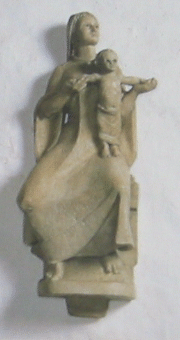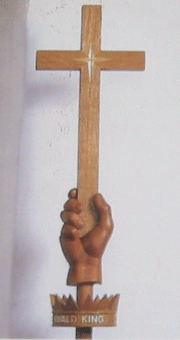| St Oswalds Church Grasmere | by © |
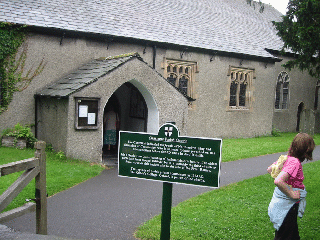 The plaque for Grasmere Parish Church:-
The plaque for Grasmere Parish Church:-The church is dedicated to Oswald of Northumbria, king and champion of Christianity, who is believed to have preached on this site sometime before 642AD, when he died in battle. It is a Grade One Listed building of national historic interest. The oldest parts date from around 1300AD, but it is probably the third church to have stood on this ancient site by the side of the River Rothay. The register of parish priests commences in 1254AD. The Queen's College, Oxford is patron of the church. | ||||||||||||||||||||||
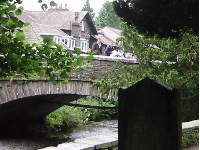
 Next morning we explored Grasmere, including St Oswald's church beside this bridge.
This is the church where our Otley and Rigg ancestors worshipped.
Next morning we explored Grasmere, including St Oswald's church beside this bridge.
This is the church where our Otley and Rigg ancestors worshipped.
| ||||||||||||||||||||||
|
Contempories of Jonathan Otley 1766 - 1856 John Dalton 1766 - 1844 who called Jonathan his friend and shared his interest in the Lake District. About 1800 they worked together to determine the composition of gas from the floating island in Derwent Mere. William Wordsworth who is buried at Grasmere. | ||||||||||||||||||||||
 Jonathan Otley 1766-1856, was christened here.
Jonathan Otley 1766-1856, was christened here.My first page about Jonathan Otley is at my family site. My second page is about Jonathan Otley's childhood home, Nook House, Loughrigg later called Scroggs House. Page three recalls Jonathan's adult life Grasmere Church is where Jonathan was baptised. These pages are the result of a visit on Wednesday 9 July, 2003, with work shared by Keswick Museum keeps Jonathan's spirit alive. These and other sites which mention him will be added to the Index page.
| ||||||||||||||||||||||
The church was built about 1250, with Chancel, Nave, Porch and Tower. By 1500 it was too small, and the seating was doubled by adding the Langdale Aisle to the north, with the former North wall pierced in five places to make the arches. The roof was 'taken down and maide oop again' in 1562 when John Benson of Baisbrown bequeathed money. The builders added a second tier of arches on the middle wall, to support the new 'third roof' overarching the existing beams. | ||||||||||||||||||||||
| ||||||||||||||||||||||
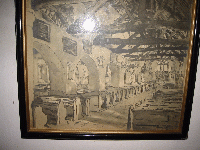 The Parish of Grasmere consisted of three ancient Townships, and each had its own gate, part of the church and graveyard. The Grasmere entry was the North or Lych Gate where the Gingerbread shop is now located. The Rydal-Loughrigg-Ambleside township entered by the South Gate, near the Porch and the Langdale entrance was opposite the Church Stile (now the National Trust shop and an art studio).
The Parish of Grasmere consisted of three ancient Townships, and each had its own gate, part of the church and graveyard. The Grasmere entry was the North or Lych Gate where the Gingerbread shop is now located. The Rydal-Loughrigg-Ambleside township entered by the South Gate, near the Porch and the Langdale entrance was opposite the Church Stile (now the National Trust shop and an art studio).The Le Fleming family were patrons of the living of Grasmere until 1970. Fittings provided by them include the 'capacious pew' opposite the Choir stalls in 1633, the boards above the altar window bearing coats of arms (known as achievements or 'hatchments'), and the two largest bells recast in 1731 carry their arms.
Until 1840 the floor of the church was bare earth, and the bodies of worshippers were buried beneath it. Then the floor was raised and flagged, and new deal benches replaced the narrow oak ones. Two dated 1635 are retained and placed near the tower door. In 1881 the present oak pews were installed.
| ||||||||||||||||||||||
St Oswald's Day is 5th August. The Churchwardens accounts for 1680 include 'For Ale bestowed on those who brought rushes and repaired the church - one shilling'. One hundred years later, in 1781, Jimmy Dawson composed a special tune for the Rushbearing March which he led with his fiddle. I can not imagine 15 year old Jonathan, his father and two big brothers missing out! 14 year old Jane and her friends made garlands for the procession, one was chosen as Queen and her garland was placed on the altar, the others decorated the church, in particular on shelves placed between the pillars for the occasion. The floor of the church was earth. In July the Clerk reminded the people that it was time to collect the rushes, known as 'seives' that grew on the fells - cart loads were needed. The old rushes were removed, the floor raked and the centre 'alley' of paving stones adjusted. The traditional Bearings were brought out of storage and refurbished, garlands and tributes (called bearings) were woven and the Saturday afternoon Procession was led by the Choir. They wove round the streets back to the church, magically strewn with fresh green rushes, for a Service followed by fun. In 1819 the Churchwarden's accounts include 3s 9p paid to George Walker for 'Rushbearers Gingerbread', marked with the stamp of St Oswald. The Churchwardens presented each Bearer with a slice, after they found a location for their Bearing. On Monday these Bearings were collected and prepared for storage, packed carefully so the tradition could continue. | ||||||||||||||||||||||
Census of 1881 lists the members of the Le Fleming family living at Rydall Hall
|
| by © 4 x great neice |


